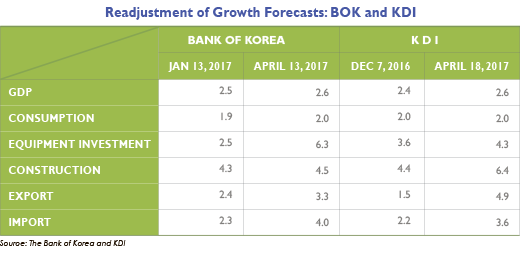
Two of the most renowned economic
research institutes in
Korea have recently modified
their economic forecasts for
2017. Led by the Bank of Korea (BOK),
which adjusted the country’s growth projection
from 2.5 percent to 2.6 percent for
2017, the Korea Development Institute
(KDI) has also upgraded it projection levels
from 2.4 percent to 2.6 percent. In a
span of just three to four months, both
institutions changed their views of the
2017 Korean economy and upgraded
growth rates by 0.1 to 0.2 percentage
points, making their forecasts identical at
2.6 percent. But despite this similar
action, the reasons behind their hike are
quite different.
For the BOK, the prime reason for its
projection growth comes from the rise of
equipment investments. In the previous
projection published in January 2017, the
BOK expected equipment investments to
grow by 2.5 percent. But in the April, it
modified it to 6.3 percent, rendering an
increase of 3.8 percentage points.
Equipment investment, which takes up
about 30 percent of the GDP, would have
contributed to an increase of 1.14 percentage
points in the GDP growth rate.
On the other hand, KDI’s revision of its
economic forecast is mostly due to the
export sector. Previously, KDI projected
that exports would grow 1.5 percent for
2017, but now changed it to 4.9 percent—
equivalent to almost 1.7 percentage
points in the GDP growth rate.
Therefore, despite the apparent similarity
in raising the growth forecasts for 2017,
the BOK underscores equipment investment
while KDI stresses exports.
Equipment investment has been generally
lackluster in 2016, showing negative
growth rates at about –2.3 percent. So, a
recent acceleration in this sector might
have been a natural rebound from its
decline in 2016. As
 the average growth
rate of equipment investment fluctuated around 2 percent for the last six years, the
BOK’s forecast of a 6.3 percent increase
in 2017 seems somewhat astounding.
the average growth
rate of equipment investment fluctuated around 2 percent for the last six years, the
BOK’s forecast of a 6.3 percent increase
in 2017 seems somewhat astounding.
Exports, meanwhile, began improving
from the middle of 2016 and finally ended
the months-long streak of negative
growth. In the first two months of 2017,
export grew at 20 percent compared to
the year before, and this trend is expected
to continue.
But there are some issues that the
Korean government should pay close
attention to in order to accelerate export
growth in the future. First, recent prices
of semiconductors and petrochemical
products have been declining, creating a
strain on two of Korea’s most powerful
export markets. Second, the yen has been
depreciating since Brexit. Last June, it hit
JPY 101 per dollar, rebounding back to
JPY 116 by December. Although fluctuating
early this year, it still remained
above the JPY 110 mark, which is still 10
percent higher than last year. Third, the
Korean won has been appreciating quickly
from around KRW 1200 per dollar to
KRW 1100. Fourth, retaliatory measures
by China after the decision to deploy
THAAD (Terminal High Altitude Area
Defense) are casting a cloud over Korea’s
export environment.
Considering these challenges, Korea’s
growth engine should be sought after
in two areas: investment and consumption. Here, the expansionary fiscal policy of
the central government should play a key
role. On this note, the IMF and the US
Treasury Department suggested that the
Korean government should expand its fiscal
policy function to encourage economic
growth.
Taking this into mind, the Korean government
should think about which fields
to focus its fiscal expenditures on. The
primary area of fiscal action could be on
welfare expenditures, supporting the
unemployed, the elderly or the disabled.
It could also be spent on R&D to assist in
the growth of new technologies and products.
Other options include renovating old
towns and villages, educating the youth
and enhancing the competitiveness of
industries through investments. With the
new administration soon to take office,
political leaders must find a consensus on
which areas need fiscal action first.